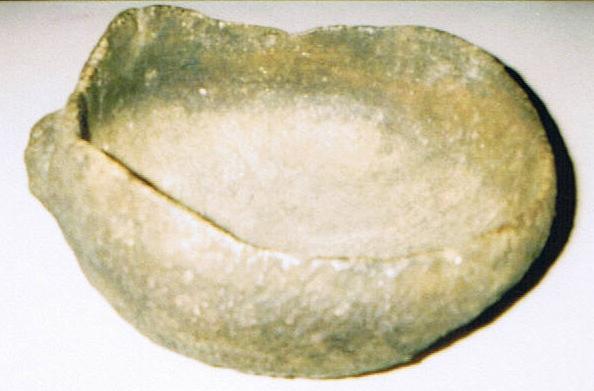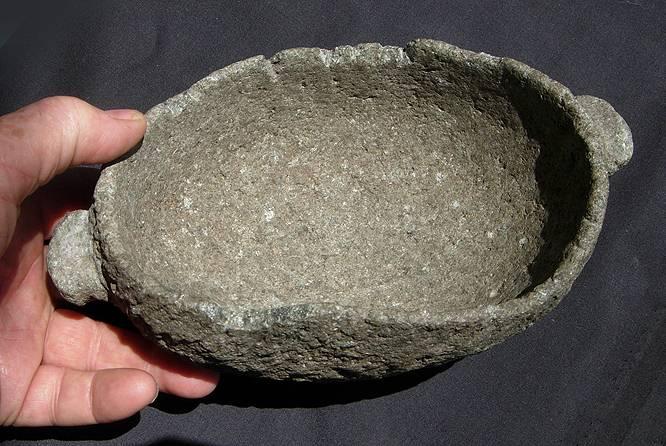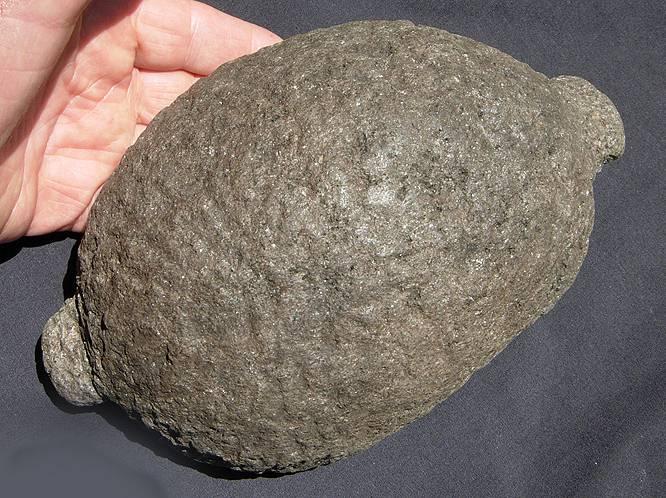
While not exactly pottery, steatite vessels were the first forms used for cooking beyond the use of gourd containers, wooden bowls, shell cups, baskets or animal skins and bladders used to contain food or drink. Many objects have been made from steatite throughout history, but this article is concerned with the containers or bowls made by early man in the Southeast. The other products of the steatite industry will be described and discussed by artifact type in other locations within the web site.
Archaeologists have noted the close resemblance of early pottery and carved soapstone containers, which may have been manufactured in Virginia by 4,500 years ago. Not only was soapstone fashioned into thick, heavy containers, a few appearing like mortars, but also into rather elegant, thin bowls. Oval and round shapes appear on small-to-large, shallow-to-moderately-deep bowls. Black smudges on soapstone vessels indicate that they were used for cooking. Soapstone vessel manufacture was limited to a few places in Virginia where the stone occurs naturally. Archaeologists have identified quarries in Fairfax, Orange, Madison, Albemarle, Nelson, Amelia, and Brunswick counties. Manufacturing vessels, establishing trade networks, and transporting and repairing soapstone vessels took a great deal of effort. Furthermore, there probably existed competition for vessels, and only a small social segment of the people were able to afford and obtain the containers.
The original demand for soapstone vessels may have created a need for inexpensive durable vessels that could be produced anywhere from local clays and used by everyone. Although the quarries contained an unending supply of soapstone, the production and exchange networks may not have been able to meet the demand. This may in part explain why ceramic production was accepted first in areas far removed from soapstone quarries.
The earliest ceramic vessels are approximately the same size and shape as soapstone vessels and have similar lug handles. Early pottery vessels even contain soapstone, perhaps broken pieces of stone containers, as temper in their paste. This could be interpreted as a symbolic transference of strength and durability from the stone containers to the ceramic vessels.
In order to make a steatite vessel, mushroom-shaped blanks were carved from boulders of steatite. This part of the process was carried out at sites like Stoapstone ridge, located in southeastern Atlanta near the I-285 corridor. Many unfinished bowls and broken chisels have been recovered from this and many other sites scattered across North and Central America.

These blanks were then carved using a wooden mallet and a chisel made from a deer antler.


The exterior of the vessel was often left roughened by the chiseling process. Lug handles on either end were often made as a means of handling the hot stone during the cooking process. When the bowls were completed they could not only be used for storage, but they could also be used in cooking by being placed directly over a fire.
Some bowls were nicely finished like this one from the collection of Gary Davis (left) or this one struck by a plow in Upson County, Georgia or a third example found in Houston County, Georgia.
Other wide, shallow vessels like the one above (top) or this one from the collection of Jacky Fuller (left) and the University of Georgia (right) are assumed to be salt pans.